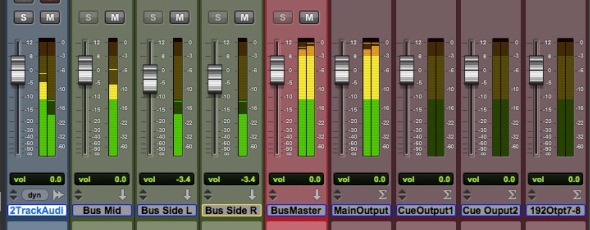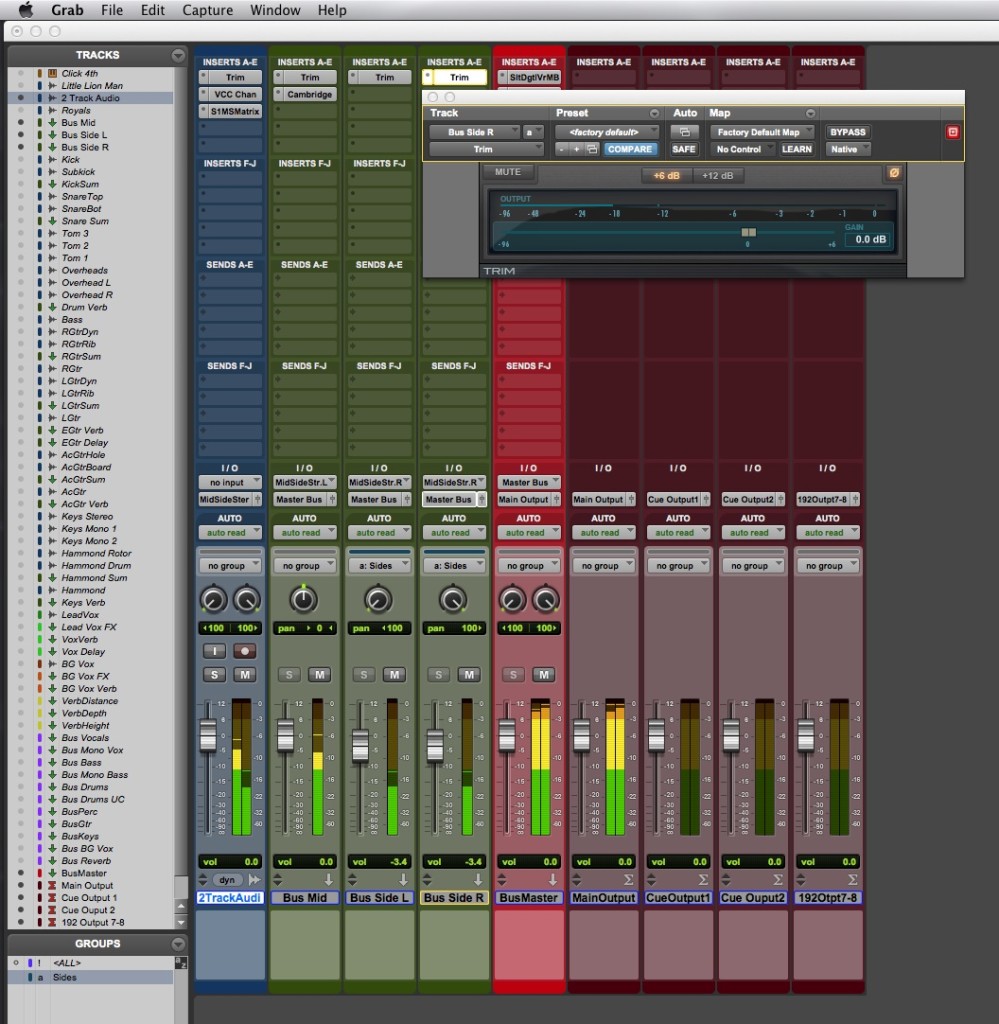When working with artists during pre-production or recording rehearsals, I will often use a handheld, digital recorder with built in stereo mics for capture. Because of sheer convenience when on location, it’s really easy to pull out the digital recorder and hit record. Often times though, the resulting stereo WAV files lack a lot of definition because they’ll typically have a large amount of room sound that makes everything really muddy. Using mid-side processing on the stereo file, I can clean up these stereo files and fix some of these issues. Here’s how I do it.
First, I’ll setup my session in Pro Tools as pictured below (click on it to enlarge it):
The stereo audio track goes on the blue stereo audio channel. I set the output of that channel to a stereo bus that I’ve named MidSide Stereo Bus. As an insert of this channel, I’ll add a mid-side conversion plug-in, in this example the MS Matrix plug-in. I’ll then create three mono aux channels. As you can see, I named the first one Bus Mid, the second one Bus Side L, and the third one Bus Side R. On the Bus Mid aux channel, I’ll set the input as MidSide Stereo Bus Left; the left mono channel of the MidSide Stereo Bus I created. On BOTH Bus Side aux channels, I’ll set the input as Mid Side Stereo Bus Right; the right mono channel of the MidSide Stereo Bus I created. I will leave the Bus Mid aux channel panned in the center. I’ll pan the Bus Side L aux channel to the left and the Bus Side R aux channel to the right. I will typically then group the Bus Side L and Bus Side R channels so that adjusting the fader adjusts both channels. Next, and most importantly, I’ll add the trim plugin to the Bus Side R aux channel and reverse the phase on that channel only as pictured. I will then output all three aux channels to my stereo Master Bus.
The MS Matrix plugin is a mid-side converter that can convert a stereo input to a mid-side output. When applied to a stereo audio file, the left output will be the sum of the mid and side signals and the right output will be the difference. Quite simply, the middle of my stereo track, which will usually be the vocals, bass, and drums depending upon where I setup my digital recorder in the room, will be sent to the left input of my MidSide Stereo Bus and the sides of my stereo track, the guitars, keys, and room sound for example, will be sent to the right input of my Mid Side Stereo Bus. By splitting those outputs out over my three aux channels and reversing the phase of one channel, the Bus Mid channel will control the level of the sound in the middle and the two Bus Side aux channels will control the sounds on the side. This means that I can turn down the side instruments or room sound and turn up the items in the middle and process them separately for more clarity.
As a practical example, we were recording a rehearsal for a band in a large metal barn with a concrete floor. I setup the digital recorder, that has a xy microphone pair built into it, so that the vocals, bass and drums were in a straight line right down the middle. On the left and right sides of these elements were two guitar players. With nothing to dampen the room reflections, it was a VERY live. After we got back to the studio, it was almost impossible to make out some of the parts due to the massive amount of reflection/reverb. I setup my aux channels as noted here and was able to simply turn down the sides by lowering the Bus Side aux channels. Everything was much clearer and the recordings became very useable.
If you do a lot of stereo recordings, especially in a live environment, this technique can be very helpful. Using mid-side processing in this way is a quick and simple way to clean up your stereo files after the fact.



